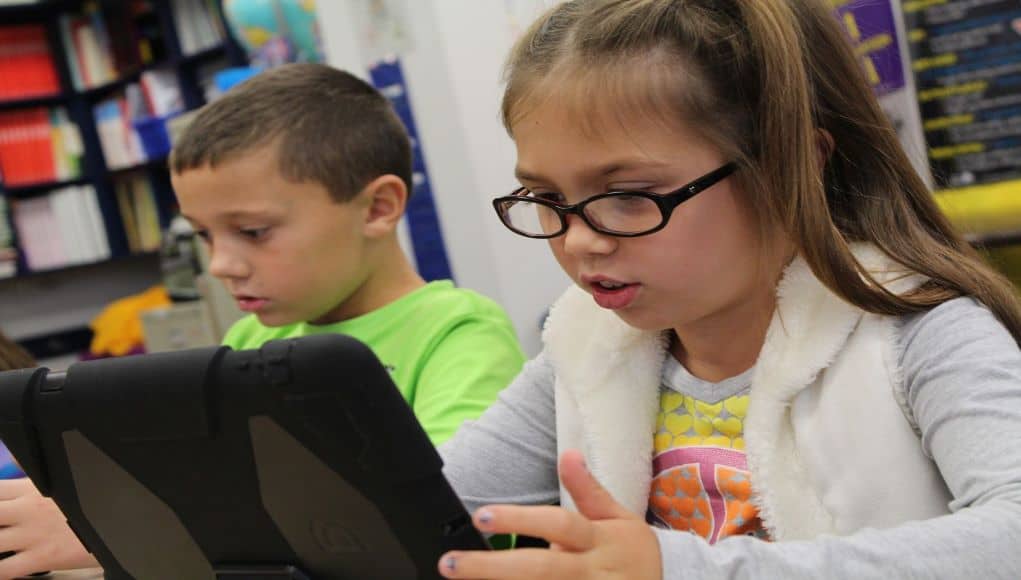Assistive Technology: Finding the Right Resources for All Students

Finding resources for our classrooms today should seem like an easy task. When it comes to technology, there are thousands of options available within seconds by completing a simple Google search. However, with so many options, the choice can become somewhat challenging. Knowing which tools will provide the best learning experience for students and that goes beyond a simple substitution of a traditional method or teaching tool, takes time. Technology is constantly changing and new apps and teaching tools are being developed every day, especially when it comes to accessibility, there are amazing developments for individuals with disabilities. The decisions we make need to be based on selecting the tools that will enrich the learning experience and provide personalized opportunities for each student, rather than based on which tools populate the Google search the fastest.
About a year ago, I wanted to learn more about the resources available to teachers for working with special needs students. I felt that I did not know enough and was overwhelmed by the amount of information available and uncertain of what I needed to know. After attending a session on inclusion at a local edcamp and then doing my own research, I felt more confident in providing for my students and sharing my new knowledge with colleagues. My experience also reinforced that collectively, all educators need to prepare by understanding the different types of tools available, learning about each student’s specific needs, and being aware of how to implement these tools in our instruction.
One area that I have focused on learning more about has been Assistive Technology. Assistive technology is used to help students who have learning disabilities overcome barriers. Assistive technology can be used for many types of learning difficulties, including listening, reading, writing, and speaking, and also assist with some routine daily tasks.
Finding the Right Information
The number of special needs students in schools was estimated at 6.6 million students making up 13% of the overall school population. An interesting fact I recently came across is that from the year 1989 until 2010, the amount of time that special education students spent in general education classrooms increased by 90 percent. With 62% of the special education students being enrolled in general education classes for the majority of the day, regular education teachers must be knowledgeable of the needs of each student and prepared to provide a variety of tools to enhance each student’s learning experience.
The ISTE (International Society for Technology in Education) Teacher Education Network recently focused on assistive technology for its monthly newsletter and Twitter chat. Each month we focus on a specific theme and our goal is to gather resources through multiple avenues. This supports a thorough collection of information shared with the ISTE community and our own professional learning networks (PLN).
In our February newsletter, there were several guest posts which shared information about many of the tools, strategies, experiences and best practices when it comes to assistive technology. If you are looking for organizations or people or hashtags to follow on Twitter or just some ideas of tools specific to writing skills or reading skills, you will find the newsletter to be full of helpful information and tips. While it is impossible to know everything, educators can stay current with the best practices and tools for fostering an inclusive learning environment by being part of a learning community. ISTE and its state affiliates provide increased access to resources through Twitter Chats and other forms of social media for learning.
Resources to Try
There are many tools available to educators and families to help students with the process of learning, in particular, those who may struggle with some aspects of the learning process. It is important to make sure that the tools are accessible and work on different devices and that there is a way to find tech support if needed. Here are some tools and websites for getting started. While not all tools necessarily work on each device, the majority of those listed will be accessible. There are also some really good apps available, among thousands to choose from, but these can be used in multiple grade levels and content areas.
- Microsoft Learning tools. As a Microsoft Innovative Educator Expert, I enjoy being part of a learning community that is dedicated to lifelong learning and providing tools and resources that promote personalized learning and accessibility for all. Through Microsoft Learning Tools, students can improve reading and writing skills through the use of the Immersive Reader, Speech to Text and Text to Speech, and improve comprehension using the picture dictionary if needed. Students simply hover over a word to see a picture representation in order to determine meaning.
- Read and Write enables students to interact more closely with a document by using the text to speech (TTS) feature to hear the words, use the text and picture dictionaries to understand the meaning of words, and create a summary or simplify the webpage by removing distracting ads.
- Screenleap for Education allows teachers to share their screens with students and record it for later viewing. Using a tool like Screenleap is a great way to provide students with access to the lesson to review when they need it, providing more accessibility to the right tools for reviewing the content material.
- Assistive Tech for Reading, Writing and Math – Some examples of tools available are Bookshare, an online database of books available to students with a documented print disability. Using a tool like Natural Reader, students can copy text or import a document, choose from a variety of speaking voices and speed, to listen, or read along as the text is read for them. Rewordify is helpful for students working on reading skills and comprehension, as it takes the text input and replaces the more difficult words so students can build on their skills. SpeakIt! is a free text to speech app available in 50 languages, where students highlight the text to be read and can then practice.
- Quizlet offers many options for practicing vocabulary through flashcards that include an audio component through TTS. The availability of different activities for learning and reinforcing the content offer more personalized options for students.
- Augmentative and Alternative Communication Tools – TapTapSee is a free app on iOs and Google Play that can identify objects once the user “taps” the screen to take a photo of an object and then can listen to the description (if Talkback is enabled on the device). Let me talk is a free AAC app where you can line up images and have them read back as a sentence. Speech Assistant is a free medical AAC app that helps people with speech impairments create sentences by typing in words or selecting images from categories in order to communicate. Symbo Talk is a free app with communication boards that provide a voice to those who are unable to speak for themselves.
- Learning and Attention Apps lists eight apps listed that offer students tools for text to speech, organizational tools, help with staying focused and even note-taking strategies through the app. Most are free and available on iOs with some available now on Android.
- Understood is an organization that is focused on providing resources for students and their families on topics such as learning and attention issues, feelings, school and learning, and assistive technology, as well as many other areas.
- Early Childhood Education Zone offers the 20 best apps for special education for students with Autism, or ADHD, and provides links directly to the App store to purchase or download the free apps.
- Artificial Intelligence – Using virtual assistants such as Alexa, Bixby, Echo and Siri can help students with physical disabilities, or visual or motor impairments have better access to information and additional learning resources without the barrier of interacting with a physical device.
Takeaways
The most important step is to always start by getting to know your students. Building relationships are the most important aspect of our role as educators. Find ways for students to interact by including time for students to work together and learn about one another. Sometimes technology is the way to do this, choose a game or find a resource online that students can engage in together. Make time to connect with families and share the resources that are being used in school so that families can provide the same support at home. Also don’t be afraid to reach out to the special education teachers in your building or even through social media like Twitter, follow hashtags such as #specialeducation, #spedchat, #inclusion. We are preparing students for the future and need to provide all that we can to give them the best opportunities for learning and growing together.
For more, see:
- Working with Special Needs Students: What Do All Teachers Need to Know?
- Microsoft Inclusive Classroom Adds Picture Dictionary
- 7 Apps for Working with Special Needs Students
Stay in-the-know with innovations in learning by signing up for the weekly Smart Update.








Judith Presley
It's actually not an easy task to find resources and technologies that will make the process easier, that is, that will really work.
I am also interested in this topic, and I think I will always be looking for something extra. Since teaching children with disabilities is always an individual process, and what works for one will not work for another. Here is a useful article about assistive resources that slightly expands the topic: https://www.school-for-champions.com/mentalhealth/resources.htm#ADHD_Children
Reading and writing applications are my most needed resources so far, as reading and writing are basic skills.
Also in special cases, planning and focusing apps are of great help - most often on the phone (MindNote and others).
Thank you for these lists, I think I will find something new and untried for my work.